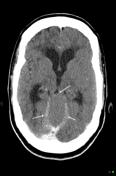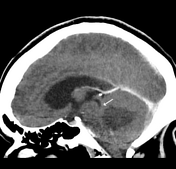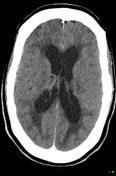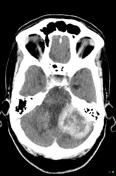Presentation
Past history of breast cancer, now headache and reduced conscious state with cerebellar signs
Patient Data
Note: This case has been tagged as "legacy" as it no longer meets image preparation and/or other case publication guidelines.






Upward herniation of the superior vermis through the tentorial hiatus (arrow) together with edema in the brain stem causing aqueduct obstruction (arrow) and resultant lateral and 3rd ventricular dilatation with periventricular (interstitial) edema due to the rapidity of onset. Note large enhancing mass in the left cerebellar hemisphere (metastasis) responsible for the mass effect.




 Unable to process the form. Check for errors and try again.
Unable to process the form. Check for errors and try again.